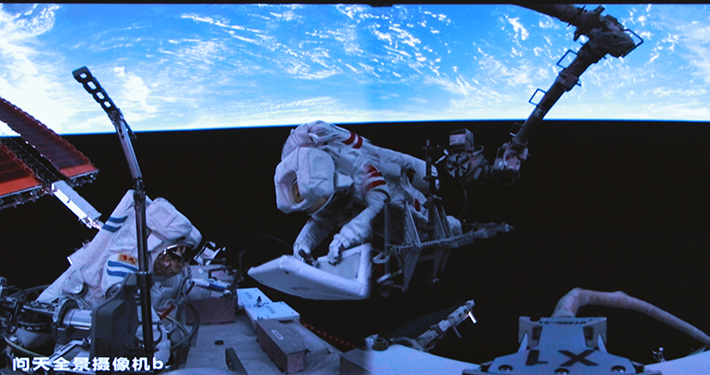|
||||||||||
| Home Top News Economy/Tech Culture/Sports China in Foreign Eyes Green Development Videos Intangible Cultural Heritages |
|
||||||||||
| Home Top News Economy/Tech Culture/Sports China in Foreign Eyes Green Development Videos Intangible Cultural Heritages |
| ChinAfrica |
| Aiding Space Exploration |
| China’s new generation of extravehicular space suits achieves its life extension objective |
| By Ge Lijun | VOL. 17 October 2025 ·2025-10-10 |

Screenshot from the Beijing Aerospace Control Centre showing taikonauts Chen Dong (left) and Chen Zhongrui working outside the space station during the Shenzhou-20 mission on 26 June (XINHUA)
Deep space is incredibly quiet, but once astronauts leave the station, they must contend with extreme temperatures, fluctuating pressures, and high levels of radiation. Their spacesuits are equipped with life-support systems, which are essential for a safe “walk in space.” On 15 August, the crew of Shenzhou-20 successfully completed their third spacewalk. For this mission, taikonaut Chen Dong wore the extravehicular spacesuit B, which has now been used in 20 spacewalks. With this achievement, the space station has reached the target of “four years and 20 spacewalks.”
The Chinese space station is currently using the second-generation Feitian spacesuits, developed entirely in China. These suits are designed to last for three years and support at least 15 space missions, significantly improving upon the first generation. This ensures that astronauts can perform spacewalks more safely and efficiently.
On 4 July 2021, during the Shenzhou-12 mission, two Chinese astronauts debuted the new models A and B of this generation and successfully completed their spacewalks, immediately demonstrating their robustness. By early 2024, these suits were already approaching the end of their operational lifespan.
Could they still be used? To work out how long they’d last, the science team set up a strict monitoring and testing plan in orbit. The result was that, with the B suit in a stable condition, it became the first space product to have its life extended after an in-orbit evaluation. So far, 11 astronauts have used it on eight manned missions. Once it’s retired, it’ll come back to Earth to undertake new scientific missions.
The extravehicular spacesuit is essentially a miniature spaceship, packed with cutting-edge technology. Its multi-layer design provides protection against radiation and extreme temperatures.
The second-generation Feitian family includes three models: A, B, and C. On 15 July, the Tianzhou-9 cargo ship delivered two new models, D and E, which are ready for use. Their performance has been optimised, extending the expected service life from three years and 15 spacewalks to four years and 20 spacewalks.
Depending on the nature of the mission, there are spacesuits designed for low-Earth orbit, the Moon, and Mars. The demands of manned spaceflight are constantly driving the development of these technologies. Thanks to joint advances in materials, AI and robotics, extravehicular space suits will play a key role in the exploration of the universe in the future.
|
||||||||||||
| About Us | Contact Us | Advertise with Us | Subscribe |
| Copyright Beijing Review All rights reserved 京ICP备08005356号-5 京公网安备110102005860号 |